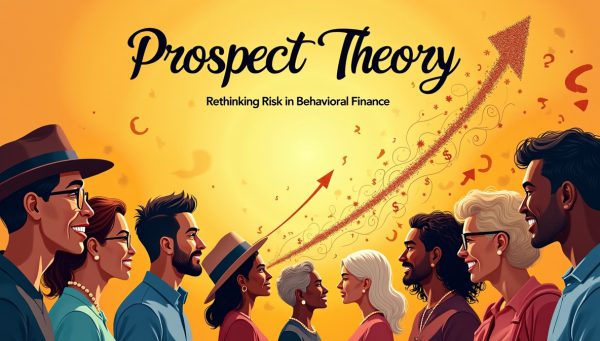
Prospect Theory in Behavioural Finance
May 3, 2025
What if the secret to winning in markets isn’t numbers or algorithms, but the twisted wiring of your brain? Prospect theory slashes through classical economics’ neat assumptions, exposing how our minds sabotage us. Behind every trade, there’s a mess of emotions—fear, greed, hope—making decisions far from rational.
This framework forces us to stare down our cognitive biases and rethink the myth that we always act logically. It shines a brutal light on how we shrink from risk when we’re ahead but chase wild bets when facing losses. This emotional see-saw shapes every market move, every portfolio twist.
The Genesis of Prospect Theory: A Revolution in Decision-Making
Born from cold experiments that busted the myth of rational man, prospect theory reveals how our choices are shaped not just by the raw numbers, but also by how outcomes are framed. The gut punch? Losses sting more than gains satisfy—loss aversion rewrites the risk playbook.
This insight isn’t academic fluff—it explains why investors hold dead money hoping for a miracle and why bubbles explode with irrational euphoria. Understanding this flips the script on decision-making, demanding we respect the psychological battleground beneath the charts.
The Duality of Gains and Losses: Psychological Underpinnings and Cognitive Bias
Prospect theory is all about one brutal paradox: we clutch gains tight, avoiding risk, yet when losses hit, we gamble recklessly, trying to claw back. This split personality drives markets—safe on the way up, wild on the way down.
Picture an investor riding a winning streak: they get cautious, locking in small gains to avoid loss. But when the tide turns, that same person might throw caution to the wind, chasing big risk in a desperate bid for recovery. This contradiction distorts markets and renders usual risk controls nearly useless.
The power lies in recognising this tug-of-war within us. Once you see how your brain twists value based on context and framing, you gain a weapon: the ability to step back, question impulses, and make smarter, more deliberate choices. This is survival and edge in a market ruled by collective psychology and emotional chaos.
The Framing Effect: How Presentation Shapes Perception and Action
A central pillar of prospect theory lies in the framing effect—the notion that how a choice is presented can significantly alter our perception of risk and reward. Consider two scenarios: in one, an investment is described as offering a 70% chance of profit, while in another, the same proposal is presented as bearing a 30% risk of loss. Despite being mathematically identical, the emotional impact of these framings is profoundly different. Most individuals will be more inclined to embrace the opportunity described in positive terms, even if the underlying probabilities remain unchanged. This subtle yet potent influence pervades every facet of financial decision‐making, from individual portfolio management to the collective mood that drives market trends.
Historically, the framing effect has been implicated in numerous market phenomena. During periods of economic exuberance, for example, optimistic framings of growth prospects can trigger waves of irrational buying, inflating asset prices beyond their intrinsic value. Conversely, in times of downturn, bleak descriptions of market conditions can precipitate panicked sell-offs as investors cling to the hope of mitigating losses rather than assessing long-term prospects rationally. Such dynamics reveal how perceptions, more than objective reality, govern market behaviour—a sobering reminder that the effective presentation of information can be as influential as the information itself.
For the modern investor, an acute awareness of the framing effect is invaluable. By consciously seeking to reframe decisions and dissect the language used in financial reports, news, and analyst recommendations, one can achieve a level of cognitive clarity that bypasses the seductive allure of emotionally charged narratives. This may involve constructing decision matrices that emphasise objective criteria or dedicating time to reflective journaling that captures the emotional context of market choices. Ultimately, mastering the framing effect is not solely about avoiding pitfalls; it is also about seizing the initiative when others are clouded by sentiment—a strategy that can yield substantial rewards when applied with precision and diligence.
Actionable Strategies: Harnessing Prospect Theory for Investment Success
Armed with the insights of prospect theory, the discerning investor can transform cognitive biases into a strategic advantage. The first step is recognising and quantifying one’s susceptibility to emotional distortion. This endeavour might begin with a thorough review of past trading decisions, identifying patterns where feelings of loss or excessive caution skewed rational judgment. By documenting these instances and analysing the resultant outcomes, one lays the groundwork for a more informed, calibrated strategy. Such introspection serves as both a diagnostic tool and a roadmap for future improvement.
A practical strategy derived from prospect theory involves deliberately structuring investment choices to counteract inherent biases. For instance, consider the use of predetermined stop-loss orders, which can act as a safeguard against the impulsive risk-seeking behaviour that often emerges in the face of losses. By establishing clear exit points, the investor limits potential damage and reinforces a mindset grounded in reason rather than emotion. Similarly, setting rigid criteria for profit-taking can counteract the paralysing effect of risk aversion in thriving market conditions. These measures, when employed consistently, create a disciplined environment in which systematic analysis rather than transient sentiments guides decisions.
Furthermore, the concept of mental accounting—another derivative of behavioural insights—encourages investors to compartmentalise assets based on their function and risk profile. By treating gains and losses as separate accounts with distinct rules for rebalancing and reinvestment, one can mitigate the psychological impact of any single setback. This segregation not only enhances overall portfolio stability but also enables more nuanced responses to market fluctuations. Advanced strategies may also include the use of options to hedge against adverse movements, capitalising on the often inflated volatility premiums that emerge during periods of heightened uncertainty. By selling put options when fear drives prices down and simultaneously securing long-term positions through LEAPS, an investor can create a position that leverages temporary market inefficiencies for lasting benefit.
These actionable strategies, rooted in the insights of prospect theory, remind us that recognising our cognitive fallibilities is not a call to despair but an invitation to adapt and conquer. In a financial world dominated by fleeting trends and emotional extremes, the power to reframe our decision-making processes transforms potential obstacles into stepping stones towards sustainable success. The ultimate goal is to build a portfolio and an investment philosophy where every decision is the product of thoughtful deliberation, fortified by robust risk management and guided by a clear understanding of behavioural dynamics.
Integrating Timeless Wisdom with Modern Cognitive Insights
Throughout the ages, thinkers and philosophers have grappled with the duality of risk and reward, as well as the delicate art of decision-making. From the Stoic meditations of ancient scholars to modern cognitive science, a persistent truth remains: the quality of our choices defines the trajectory of our lives. With its nuanced portrayal of how we evaluate gains and losses, the prospect theory embodies this timeless wisdom in a context uniquely suited to today’s dynamic markets. It prompts us to recognise that while numbers and charts are indispensable, the mind behind every decision is equally, if not more, consequential.
Integrating these perennial insights with contemporary investing techniques creates a hybrid framework that is both robust and adaptable. Imagine a world in which every investor is not only a master of technical analysis but also a keen student of human psychology—a world where the warnings of loss aversion are met with deliberate countermeasures and where structured, pre-planned responses temper the seductive pull of risk. Such integration empowers individuals to navigate the turbulent seas of market uncertainty with both the precision of a seasoned strategist and the calm wisdom of a philosopher.
This synthesis of timeless wisdom and modern cognitive insight requires ongoing self-education and reflective practice. It begins with the willingness to question entrenched assumptions and to embrace the complexity of human thought. In this pursuit, every market misstep becomes an opportunity for rigorous self-examination—a chance to identify where emotion outweighed reason and how such lapses might be prevented in the future. Whether through detailed post-trade analyses, peer discussions, or even professional coaching, the path to mastery is paved with continuous improvement and intellectual humility.
Moreover, integrating these approaches demands a commitment to long-term thinking that transcends the ephemeral allure of short-term gains. It is about constructing a strategic vision that honours the interplay between rational analysis and emotional control. In doing so, investors transform the very nature of their engagement with the markets, shifting from reactive participants to deliberate, premeditated architects of their financial destiny. Such a mindset fortifies one’s portfolio against the vagaries of market sentiment. It offers a profound sense of empowerment—a conviction that every decision, however fraught with uncertainty, can be refined through the lens of self-knowledge and disciplined reflection.
Conclusion: The Investor’s Mind—Your Ultimate Edge
Prospect theory isn’t just a theory—it’s a blueprint for waking up from the illusion of rational investing. It tears down the myth that we’re logical machines and exposes the raw, messy truth: our brains are wired to fear losses harder than they crave gains, and to get hooked by how risks are framed.
This awareness is your power. When you face your own biases head-on, you stop being a puppet to fear and greed. You build strategies that aren’t just smart on paper but built to survive the emotional battlefield of real markets.
It’s a call to own your psychology—to use tools like stop-losses, mental accounting, and hedging not as crutches but as weapons. Invest not with blind hope or panic, but with calculated, mindful control.
Forget the old models that pretend we’re robots. Real investing demands a sharp mind that blends cold analysis with hard-earned insight into human nature. Master this, and you turn your greatest vulnerabilities into your sharpest advantages.
In the chaos of markets, clarity is your strongest armour. Let the lessons of prospect theory guide your steps—not as theory, but as your new investment creed. This is where resilience is forged, growth is earned, and the future is claimed.










